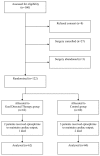Early goal-directed therapy after major surgery reduces complications and duration of hospital stay. A randomised, controlled trial [ISRCTN38797445]
- PMID: 16356219
- PMCID: PMC1414018
- DOI: 10.1186/cc3887
Early goal-directed therapy after major surgery reduces complications and duration of hospital stay. A randomised, controlled trial [ISRCTN38797445]
Abstract
Introduction: Goal-directed therapy (GDT) has been shown to improve outcome when commenced before surgery. This requires pre-operative admission to the intensive care unit (ICU). In cardiac surgery, GDT has proved effective when commenced after surgery. The aim of this study was to evaluate the effect of post-operative GDT on the incidence of complications and duration of hospital stay in patients undergoing general surgery.
Methods: This was a randomised controlled trial with concealed allocation. High-risk general surgical patients were allocated to post-operative GDT to attain an oxygen delivery index of 600 ml min(-1) m(-2) or to conventional management. Cardiac output was measured by lithium indicator dilution and pulse power analysis. Patients were followed up for 60 days.
Results: Sixty-two patients were randomised to GDT and 60 patients to control treatment. The GDT group received more intravenous colloid (1,907 SD +/- 878 ml versus 1,204 SD +/- 898 ml; p < 0.0001) and dopexamine (55 patients (89%) versus 1 patient (2%); p < 0.0001). Fewer GDT patients developed complications (27 patients (44%) versus 41 patients (68%); p = 0.003, relative risk 0.63; 95% confidence intervals 0.46 to 0.87). The number of complications per patient was also reduced (0.7 SD +/- 0.9 per patient versus 1.5 SD +/- 1.5 per patient; p = 0.002). The median duration of hospital stay in the GDT group was significantly reduced (11 days (IQR 7 to 15) versus 14 days (IQR 11 to 27); p = 0.001). There was no significant difference in mortality (seven patients (11.3%) versus nine patients (15%); p = 0.59).
Conclusion: Post-operative GDT is associated with reductions in post-operative complications and duration of hospital stay. The beneficial effects of GDT may be achieved while avoiding the difficulties of pre-operative ICU admission.
Figures



Comment in
-
Highs and lows in high-risk surgery: the controversy of goal-directed haemodynamic management.Crit Care. 2005;9(6):642-4. doi: 10.1186/cc3929. Epub 2005 Nov 22. Crit Care. 2005. PMID: 16356256 Free PMC article.
-
Optimal management of the high risk surgical patient: beta stimulation or beta blockade?Crit Care. 2005;9(6):645-6. doi: 10.1186/cc3930. Epub 2005 Nov 22. Crit Care. 2005. PMID: 16356257 Free PMC article.
-
Goal directed therapy: how long can we wait?Crit Care. 2005;9(6):647-8. doi: 10.1186/cc3951. Epub 2005 Nov 23. Crit Care. 2005. PMID: 16356258 Free PMC article.
-
Advances in protocolising management of high risk surgical patients.Crit Care. 2006 Feb;10(1):124. doi: 10.1186/cc4848. Crit Care. 2006. PMID: 16542482 Free PMC article. Review.
References
-
- Shoemaker WC, Appel PL, Kram HB, Waxman K, Lee TS. Prospective trial of supranormal values of survivors as therapeutic goals in high-risk surgical patients. Chest. 1988;94:1176–1186. - PubMed
-
- Cullinane M, Gray AJ, Hargraves CM, Lansdown M, Martin IC, Schubert M. The 2003 Report of the National Confidential Enquiry into Peri-Operative Deaths. London: NCEPOD; 2003.
-
- Campling EA, Devlin HB, Lunn JN. Report of the National Confidential Enquiry into Peri-Operative Deaths. London: NCEPOD; 1990.
Publication types
MeSH terms
Substances
Associated data
LinkOut - more resources
Full Text Sources
Other Literature Sources
Medical
Miscellaneous

